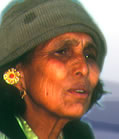THEMES IN THIS
TESTIMONY
Communications

Development

Employment and Income

Water

Click on arrows
to find more
testimonies
featuring
these themes
|
Chandra Bahadur |
(NEPAL 23) |
|
Sex
|
male
|
|
|
Age
|
55
|
|
|
Identity
|
N
|
|
|
Occupation
|
|
|
|
Location
|
Jhankri Dara, Lalitpur
|
|
|
Date
|
1998
|
|
summary
This is one of the water testimonies of which we do not have a full transcript. It is the interviewer’s edited version of the testimony and does not include any questions top the narrator.
The narrator talks in detail and enthusiastically about a ropeway his village developed together with the Bagmati Watershed Project. His village is remote and villagers cannot cultivate enough cereal produce to sustain them throughout the year. The ropeway enabled them to market their produce more effectively and thus purchase the grain and rice they required. “This ropeway is far more useful than a motorable road. This does not destroy our environment or our forest. Roads in the mountain get damaged during the rains. It is not always possible to construct roads everywhere, and road construction requires huge investments. We saw this ropeway as a simple, easy and quick alternative and made a request for it.”
He articulates his perspective of development: “Development requires a combination of many elements. We had to terrace the fields for higher yields, and then look for a market for our produce. We needed a quick and easy transportation system to take our goods to the market. The market needs fresh products… How to get fresh spinach and milk from Ikudol and Bhattedanda to Lagankhel? The answer - a ropeway.”
He concludes: “There is no other way to raise the living standard of people in this remote area except by improving agricultural practices and setting up markets.”
detailed breakdown
|
You will need a password from Panos to view the full
transcript of the interview. To apply for a password, click here.
Once you have a password, click here to go to the beginning
of the transcript. You can also click on any section of the
breakdown of content below and go straight to the
corresponding part of the transcript.
|
| Section 1 |
He lives in a village which, although relatively close to Kathamandu, “is a remote, mountainous region with no road network”.
They used to carry dairy products on their backs to the nearest market. Marketing cream was more profitable than butter but processing cream required much fuel wood and contributed to deforestation. “With the destruction of forests, natural calamities followed. Landslides occurred and in their wake property - land, houses and farms – was destroyed.”
He became the village chief and contacted the Bagmati Watershed Project and learnt about different ways to control erosion.
|
| Section 2 |
“The terracing of fields helped retain moisture in the soil and checked erosion.” Through the project they also built a pond to contain excess rainwater and planted trees in eroded areas. “As a result, even the landslide-prone hill is safe. All this conservation effort… has led to increased production of vegetables, fruits and dairy products… but now we had to market and sell the produce.”
They developed the idea of the ropeway as an alternative to carrying produce to the road. Describes marketing activities since the ropeway.
|
| Section 3 |
They cannot cultivate enough for the whole year so depend on income from marketing produce.
In the past cash was not necessary, now it is - especially for sending kids to school. “Even if they are poor, right-thinking parents must educate their children, by working for daily wages if necessary.”
His ideas about development requiring a “combination of many elements”.
|
| Section 4 |
They saved their secondary school by erecting flood walls/barriers.
The villagers are responsible for the operation and maintenance of the ropeway and manage this by charging people a small amount for its use.
His hopes to extend the ropeway |
|


